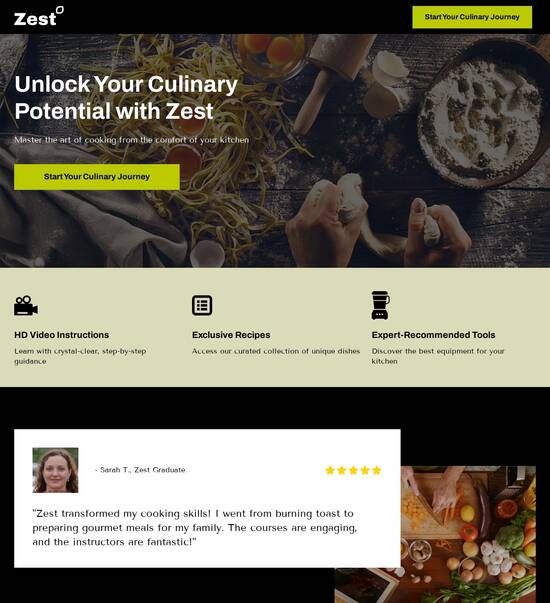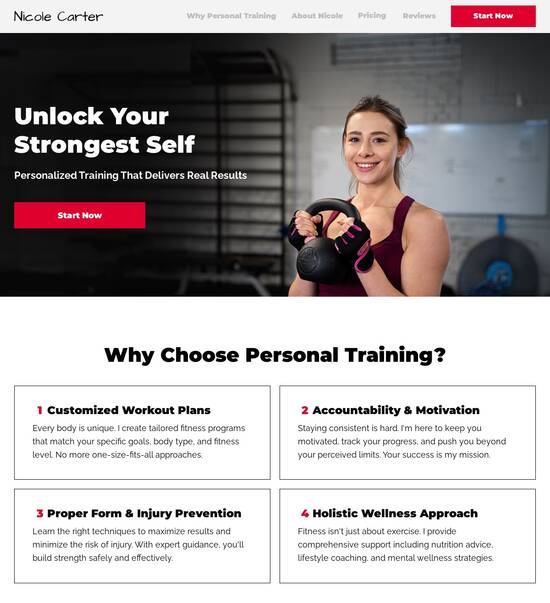
Grid-based political website template
Explore Similar TemplatesAbout template
Drive more leads with Instapage grid-based political website template built to maximize conversions. Easy customization - no designer or coding skills needed.
Recommended templates

Easy to build without coding
With the intuitive drag-and-drop builder, anyone on your team can create high-converting pages without any knowledge of code or design. Make enhancements to your landing page with custom widgets using Javascript, HTML/CSS, or third-party scripts.

Multiple layouts for any industry and goal
Select from 500+ landing page layouts built to boost conversions across industry-specific scenarios. Customize them by adjusting fonts, adding images, and generating on-brand content with the AI assistant. Quickly scale with Instablocks® and Global Blocks that you can save, reuse, and update globally.

Loads fast and looks polished on any device
Every template is responsive, which means they present professionally on any device and load blazingly fast with our Thor Render Engine. You can also power them up with Google AMP technology to deliver an unparalleled mobile experience and drive higher conversions.

Robust analytics & experimentation
Get real-time updates and reporting across all your devices, showing the number of visitors, conversions, cost-per-visitor, and cost-per-lead. Launch AI-powered experiments, run A/B tests, and use heatmaps to analyze user behavior, then optimize your landing page to maximize conversions.







Easy to build without coding
With the intuitive drag-and-drop builder, anyone on your team can create high-converting pages without any knowledge of code or design. Make enhancements to your landing page with custom widgets using Javascript, HTML/CSS, or third-party scripts.
Multiple layouts for any industry and goal
Select from 500+ landing page layouts built to boost conversions across industry-specific scenarios. Customize them by adjusting fonts, adding images, and generating on-brand content with the AI assistant. Quickly scale with Instablocks® and Global Blocks that you can save, reuse, and update globally.
Loads fast and looks polished on any device
Every template is responsive, which means they present professionally on any device and load blazingly fast with our Thor Render Engine.
Robust analytics & experimentation
Get real-time updates and reporting across all your devices, showing the number of visitors, conversions, cost-per-visitor, and cost-per-lead. Launch AI-powered experiments, run A/B tests, and use heatmaps to analyze user behavior, then optimize your landing page to maximize conversions.
All the features you need to build lead-generating landing pages
Explore more featuresLearn how to build top-performing landing pages for any goal
FAQs
Leading the way in building high-performing landing pages





The ultimate guide to leveraging Instapage for landing page optimization
Optimizing your digital marketing campaigns starts with effective landing pages, and Instapage stands out as the most powerful platform for this purpose. With a suite of tools designed to accelerate, optimize, and maximize the ROI of your efforts, you can easily align your strategies with your goals and target audience.
Understanding the power of landing pages
Landing pages play a crucial role in capturing leads and converting visitors into customers. Instapage offers over 100 conversion-focused templates that can be customized to meet specific needs for industries like education, tech, and financial services. With the right landing page, businesses can effectively communicate their value propositions and enhance user engagement.
- Unmatched customization: Tailor every aspect of your landing page without needing coding skills, allowing for a design that resonates with your target audience.
- High conversion rates: Templates are optimized to convert, leading to increased leads and higher ROI on your campaigns.
- Fast deployment: With pre-built lead generation elements, you can launch impactful landing pages in mere minutes.
Step 1: Designing your landing page
Creating an effective landing page with Instapage is simple and efficient. The platform allows you to pick a template and customize it according to your audience's needs. Options for customization include graphics, wording, and calls-to-action that speak directly to user intent.
Step 2: Optimizing for conversions
Once your page is live, it's critical to continually optimize for better performance. Instapage includes built-in A/B testing features that let you experiment with different elements. For example:
- Utilize heatmaps: Analyze visitor interactions to identify areas that need improvement.
- A/B testing: Test variations of headlines and images to see which performs better.
- Analytics dashboard: Monitor conversion rates and other metrics to fine-tune your approach.
Step 3: Personalization strategies
To strengthen your campaigns, consider personalized content. Instapage allows you to utilize dynamic text replacement, ensuring that users see relevant messages tailored to their interests.
- AdMaps: Align your ads with specific landing pages to create a cohesive user journey.
- Segmentation analytics: Track how different audiences interact to refine your messaging.
- On-going personalization: Use insights from previous campaigns to design future landing pages.
In conclusion, Instapage is not just a landing page creator but a comprehensive tool designed for optimization and personalization. By understanding and applying the features that Instapage offers, marketers can significantly enhance their efforts and overall performance.
Ready to take your digital marketing to the next level? Explore Instapage's advanced features today and see how you can accelerate and scale your campaigns for maximum impact!
Grid-based political website template: A comprehensive guide
Understanding the grid-based template concept
Grid-based layouts represent a systematic approach to designing websites, particularly beneficial for political campaigns. At its core, a grid system is a framework that divides a layout into a series of columns and rows, aiding designers in organizing content in a structured manner. The attributes of grid systems in web design include alignment, spatial relationships, and proportional arrangements, all contributing to a coherent visual flow. This method contrasts with traditional layout models, which often rely on fixed dimensions and placements that can lead to clutter and confusion, thus compromising user engagement.
In political campaigns, a well-thought-out layout is essential as it directly influences user experience and engagement. A grid-based template can effectively guide visitors through important information such as candidate profiles, campaign promises, and upcoming events. The role of visual hierarchy is particularly significant here—it helps in prioritizing information, ensuring that crucial messages catch the user's attention immediately, thereby improving retention and persuasive power.
Core features of a grid-based political website template
Flexibility and responsiveness are hallmark features of grid-based designs. With websites being accessed on various devices, grid layouts adjust seamlessly to different screen sizes. This adaptability ensures that mobile visitors experience the same engaging content as desktop users, a critical component in political campaigns where direct engagement can significantly influence voter turnout. Moreover, responsive layouts maintain usability, thus fostering a more inclusive online environment.
Customizable grids allow campaigns to create modular sections tailored to specific content types. This includes dedicated areas for events, news updates, or policy discussions. The benefit of such reorganization lies in the ability to rearrange elements to highlight urgent messages or essential call-to-action points. Furthermore, integrating multimedia elements like images, videos, and interactive features can enrich user interaction within a grid. For example, a video highlighting a candidate’s stance on an issue can be positioned prominently alongside text content to create a more immersive viewing experience.
Technical aspects enhancing user interactivity
Leveraging document.addeventlistener boosts interactivity across political websites. This JavaScript feature allows developers to easily track user interactions such as form submissions and button clicks, ensuring a responsive experience tailored to visitor actions. For instance, if a user clicks to sign up for a newsletter, the grid can dynamically update to confirm the action, keeping the user informed and engaged.
Optimizing load times is another critical aspect achievable through effective implementation of the DOMContentLoaded event. This event triggers when the initial HTML document has been completely loaded and parsed, which is significant for improving user retention. By ensuring that political websites load quickly, campaigns can reduce bounce rates and enhance overall user satisfaction, allowing users to access vital information without frustration.
Designing engaging content through grids
Structuring information effectively is key when designing a grid-based political website. Best practices involve organizing content to clearly communicate campaign messages, with an emphasis on presenting key policies and profiles succinctly. For example, using grid sections to visually separate different topics, such as economy, healthcare, and education, allows voters to easily navigate through complex information. This logical structure encourages users to digest information more thoroughly.
Visual storytelling techniques can significantly enhance the impact of a political website. By utilizing compelling imagery and strategic layouts, designers can create a narrative that draws users in. Color schemes and typography also play an essential role—the psychological effects of colors can evoke specific emotions, influencing how users perceive a candidate’s values and messages. For instance, bright colors may convey energy and enthusiasm, while muted tones may reflect seriousness and competence.
Enhancing user experience and accessibility
Ensuring readability and easy navigation is vital for engaging users effectively. Principles like color contrast and thoughtful font selection can enhance readability, making content accessible to all users. Additionally, grid designs facilitate simplified navigation pathways, preventing users from feeling overwhelmed by information. By strategically placing navigation links and using clear labeling, users can find relevant content without unnecessary hassle.
Implementing accessibility standards is imperative, especially for political websites that aim to reach diverse populations. Compliance with ADA standards should include features such as alt texts for images, clear navigation options, and keyboard accessibility. By adopting these practices, campaigns can ensure that their message reaches everyone, including individuals with disabilities, thus broadening their potential voter base.
SEO best practices for grid-based political sites
Optimizing grid structures for search engines is crucial for political websites aiming to enhance visibility. A well-designed grid layout can improve crawlability and indexability by allowing search engine bots to navigate effortlessly. Best practices involve using appropriate meta tags and ensuring header structures align with the grid format. Furthermore, strategic keyword placement and content flow should be maintained to ensure the website remains competitive in search rankings while still delivering compelling political messaging.
Developing a content strategy tailored to political messaging further bolsters SEO efforts. Creating high-quality, keyword-rich content in conjunction with grid design enables campaigns to convey their objectives clearly. This balance between SEO tactics and storytelling is essential, as compelling narratives can draw in users and encourage them to engage with the campaign.
Analytics and optimization strategies
Tracking user interaction and engagement is fundamental for any grid-based political website. Key metrics to monitor include bounce rates, time spent on the page, and interaction rates for various elements like forms and buttons. By utilizing A/B testing, campaigns can refine user experience and improve the effectiveness of their messaging, ensuring that the site's layout meets user preferences and requirements.
Making data-driven design decisions is an ongoing process. By analyzing visitor behavior, campaigns can identify weaknesses and optimize grid layouts accordingly. Implementing changes based on feedback and analytics not only leads to improved user experience but can also amplify the impact of political messaging, engaging voters in more meaningful ways.
Case studies: Successful implementations of grid-based templates
Highlighting notable political campaigns that effectively utilized grid layouts can provide valuable insights. Specific examples can showcase how strategic design choices led to increased user engagement. For instance, campaigns that prioritize clean layouts with organized content tend to resonate more positively with voters. Analyzing these implementations helps identify successful tactics that others may adopt.
In addition, lessons learned and best practices emerge from these case studies. Common pitfalls, such as overly complex designs or poor content organization, should be avoided. Innovative solutions inspired by real-world examples can be transformed into guidelines for future political campaigns seeking to implement effective grid-based web designs.
Future trends in political website design
The evolving role of grid layouts in political discourse highlights the need for campaigns to remain innovative. Predictions for the future suggest that as technology advances, grid-based designs will continue to play a crucial role in shaping political communications. Enhanced interactivity and integrations with emerging technologies will likely define the next generation of political websites, ensuring that they remain relevant and engaging.
Integrating AI and machine learning into political web design potentially offers exciting avenues for personalization. For instance, AI can tailor user experiences based on individual preferences, creating more impactful interactions. Machine learning approaches can also optimize content delivery in real-time, responding to user behaviors and adapting grid layouts to maximize engagement effectively.
Conclusion strategies and insights
Summarizing key takeaways from the exploration of grid-based political website templates reveals their transformative power in engaging users and facilitating communication. The insights into their core features, technical aspects, and strategic implementation provide actionable guidance for political campaigns aiming to enhance their online presence. Grids not only simplify content presentation but also amplify messages in a manner that resonates with users.
Encouraging innovation in political web design is essential for adapting to the ever-changing digital landscape. A call for continuous experimentation with grid-based structures will help foster a culture of collaboration between designers and political strategists, ensuring that they create effective tools to connect with voters meaningfully.
Ready to skyrocket conversions?
Supercharge your ad campaigns with high-performing landing pages
Get started














